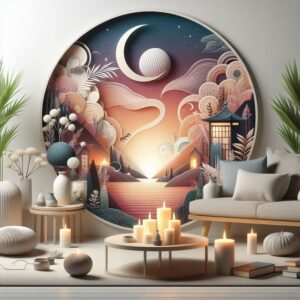
Waxing is more than just a hobby; it is an art form that transforms the act of candle-making into a therapeutic and creative ritual. With roots dating back centuries, the craft of waxing has evolved from a practical necessity to a beloved pastime embraced by enthusiasts around the world. In this article, we’ll explore the world of waxing as a hobby, its history, the various techniques involved, and the soothing benefits it brings to those who immerse themselves in this captivating art.
The Roots of Waxing as a Hobby
The history of waxing as a hobby can be traced back to ancient civilizations, where candles served as essential sources of light. Early candle-makers, known as chandlers, crafted candles using beeswax or tallow. Over time, waxing evolved from a functional skill into an enjoyable pastime for both relaxation and artistic expression.
The Therapeutic and Creative Nature of Waxing
Waxing as a hobby offers a unique blend of therapeutic benefits and creative fulfillment. The process of melting wax, choosing scents, and molding candles engages the senses and provides a sense of accomplishment as each piece takes shape.
Techniques and Varieties of Waxing
1. Container Candles: A popular technique for beginners, container candles involve pouring melted wax into decorative containers, such as jars or tins, with pre-tabbed wicks.
2. Pillar Candles: Pillar candles are molded or hand-poured candles that stand on their own without the need for containers.

3. Taper Candles: Taper candles are long and slender, making them perfect for candlesticks and creating an elegant ambiance.
4. Soy Wax Melts: Wax melts, also known as wax tarts, are small pieces of wax infused with fragrance that are melted in a wax warmer to release their aroma.
Choosing Wax and Fragrances
One of the joys of waxing as a hobby is the freedom to experiment with different types of wax and fragrances. From soy wax to beeswax, each type offers unique characteristics and benefits. Fragrance oils come in a wide variety, allowing enthusiasts to create custom scents or replicate their favorite aromas.
Mindful Relaxation and Stress Relief
Engaging in waxing as a hobby can serve as a form of mindfulness and stress relief. The repetitive motions of melting and pouring wax, coupled with the soothing aromas, can create a sense of calm and relaxation.
A Thoughtful Gift-Giving Hobby
Handmade candles crafted through waxing make thoughtful and heartfelt gifts for family and friends. Personalizing the scent, color, and style of the candles adds an extra touch of care to the gifting experience.
Connecting with a Community
The world of waxing as a hobby has a vibrant community of enthusiasts. Online forums, social media groups, and local workshops provide platforms for connecting with like-minded individuals, sharing tips, and gaining inspiration.
Environmental Considerations
As waxing hobbyists, many are conscious of using eco-friendly materials. Choosing sustainable waxes and wicks, as well as reusable or recyclable containers, aligns with the principles of environmental responsibility.

Waxing as a hobby transcends the boundaries of a mere craft; it becomes a meditative journey that combines creativity, relaxation, and a connection to tradition. The art of waxing offers a sense of achievement and fulfillment, empowering enthusiasts to craft candles that add beauty and warmth to their surroundings. Whether it’s the joy of gifting handmade candles to loved ones or the therapeutic benefits of engaging in a calming and creative process, the art of waxing has firmly established itself as a cherished hobby embraced by those who find solace and satisfaction in the flickering glow of their creations.
Create your own candles
1. Scented Container Candles: Create scented candles in decorative containers using different fragrances like lavender, vanilla, or citrus.
2. Beeswax Rolled Candles: Craft beeswax rolled candles in various colors and sizes for a natural and rustic look.
3. Floating Candles: Make floating candles that can be used to create a serene ambiance in a bowl of water.
4. Layered Candles: Experiment with layered candles, using different colored wax to create visually appealing designs.
5. Geometric Pillar Candles: Mold pillar candles in geometric shapes like cubes, pyramids, or spheres for a modern touch.
6. Gel Candles: Try your hand at making translucent gel candles, adding decorative elements like seashells or flowers within the gel.
7. Candle Carving: Master the art of candle carving to create intricate designs and patterns on the surface of the candles.
8. Marbled Candles: Create marbled candles by swirling different colored wax together to achieve a mesmerizing pattern.
9. Cupcake Candles: Have fun making cupcake-shaped candles with colorful “frosting” on top, perfect for birthday celebrations.
10. Wax Melts with Embedded Objects: Craft wax melts with small embedded objects, such as pressed flowers or small trinkets, that are released as the wax melts.
11. Taper Candles with Dipped Tips: Dip the tips of taper candles into various colors of melted wax to create a beautiful gradient effect.
12. Rainbow Candles: Make candles in all the colors of the rainbow and arrange them in a spectrum for a vibrant display.
13. Candles with Embedded Crystals: Combine the beauty of candles with the energy of crystals by embedding small gemstones into the wax.
14. Candles with Dried Herbs: Add dried herbs like rose petals or lavender to your candles for a botanical touch and a lovely fragrance.
15. Fruit-Shaped Candles: Mold candles in the shape of fruits like apples, oranges, or watermelons for a fun and whimsical twist.
16. Recycled Wax Candles: Use leftover wax from old candles to create unique, multicolored candles with a textured appearance.
17. Scented Wax Sachets: Make scented wax sachets that can be placed in drawers or closets to keep clothes smelling fresh.
18. Candles with Embedded Photos: Create personalized candles with embedded photographs, perfect for gifting on special occasions.
19. Candles in Vintage Containers: Repurpose vintage teacups, jars, or tins as candle containers for a charming and nostalgic look.
20. Layered Sand Candles: Combine wax and colored sand to create layered sand candles that resemble beautiful beachscapes.
Remember to always follow safety guidelines when working with wax and open flames, and have fun experimenting with these waxing projects to create beautiful and unique candles to enjoy or gift to others.
Related Posts
How to become an art collector1. Research: Start by researching the styles of art that appeal to you. Visit art galleries, museums, and exhibitions to develop an understanding of various artists and their works. 2. Build a network: Connect with people who are interested in art and attend events and meet-ups related to art. This will help you gain knowledge and make informed decisions about buying artworks. 3. Budgeting: Decide on a budget based on your goals and financial capacity. You can start with buying affordable and emerging artists' works and later move to contemporary or established artists. 4. Purchase: Start by buying art from reputable dealers, galleries, and auction houses. Be careful of scams and always verify the authenticity of the artworks. 5. Storage and maintenance: Invest in proper storage and handling of artworks to ensure their preservation. 6. Diversify your collection: As you collect, diversify by acquiring different genres, periods, and styles of…
Elevate Your Living Space: The Art of Decorating with ArtYour living space is a canvas waiting to be adorned with creativity and personality. One of the most captivating ways to enhance your home's ambiance and express your unique style is through the thoughtful use of art. Whether you're an art aficionado or a novice appreciator, this article will guide you through the art of decorating with art to transform your living space into a captivating and harmonious sanctuary. 1. Reflect on Your Aesthetic Taste Before diving into the world of art, take a moment to reflect on your aesthetic preferences. Consider your favorite colors, themes, and artistic styles. Are you drawn to modern and abstract pieces, or do you prefer classic and timeless art? Understanding your taste will help you choose artworks that resonate with your soul and complement the overall design of your living space. 2. Start with a Focal Point Select one or more prominent walls in…
Learn how to knit as a hobbyLearning how to knit can be a wonderful and rewarding hobby for those seeking to engage in a creative and relaxing activity. Knitting is a craft that has been enjoyed for generations, and is becoming increasingly popular as a pastime for those looking to unwind and connect with a like-minded community. To begin learning how to knit, it is important to gather the necessary supplies, such as yarn, knitting needles, and a pattern or resource materials. There are a variety of different types of yarn and needles to choose from, depending on your personal preferences and the project you are interested in taking on. Once you have gathered your materials, it is time to get started! Knitting involves a series of basic stitches and techniques that are easy to learn and master with practice. Online tutorials and instructional resources can be particularly helpful in learning the basics of knitting, as…
Tips to choose the art pictures for your living roomChoosing art pictures for your living room is a wonderful way to personalize your space and add character and style to your home. Here are 20 detailed tips to help you make the best choices: Define your style: Determine the overall style you want for your living room. Consider whether you prefer modern, traditional, minimalist, abstract, or other art styles that resonate with you. Consider the room's theme: If your living room already has a theme or color scheme, look for art that complements or enhances it, creating a cohesive and harmonious look. Size matters: Measure the available wall space to decide the appropriate size for your art. Avoid pieces that are too small and get lost on a large wall or too big and overwhelm the room. Balance and proportion: Consider the balance of the room when selecting art. If you have a large sofa or furniture piece on…
20 tips to decorate your house or apartment with the art printsDecorating your house with art prints is an excellent way to add personality, color, and visual interest to your home. Whether you are an art connoisseur or simply appreciate beautiful design, there are endless possibilities to introduce art into your living spaces. To help you get started, we have put together a list of 20 tips for decorating your house with art prints. 1. Consider your walls - Think about the color and texture of your walls when selecting art prints. Opt for pieces that will complement the existing aesthetic of your space. 2. Create a focal point - Choose one standout piece of art to serve as the center of attention in a room. 3. Create a gallery wall - Select a variety of prints of different sizes and styles to create a unique and eclectic gallery wall. 4. Pair with plants - Use plants to enhance the natural…
Exploring Gastronomy: The Art and Science of FoodExploring gastronomy is a fascinating journey into the world of food, where art and science converge to create extraordinary culinary experiences. Gastronomy is not merely about cooking or eating; it delves deeper into the understanding of food, its origins, preparation techniques, and how it affects our senses and emotions. Let's explore the key aspects of this captivating subject: 1. Definition of Gastronomy: Gastronomy is the study of the relationship between food and culture, as well as the art and science of food and cooking. It involves understanding the history, ingredients, techniques, and traditions that contribute to the diverse cuisines found around the world. 2. Culinary Anthropology: Gastronomy encompasses the cultural and social aspects of food. It examines how food shapes and is shaped by human culture, traditions, and customs. The way people prepare and consume food is often influenced by their surroundings, beliefs, and historical practices. 3. Science of Taste:…
Barcelona Beyond Gaudi: Savoring Art, Food, and HistoryBarcelona is a vibrant and culturally rich city that offers much more than just the architectural wonders of Antoni Gaudí. If you're interested in delving deeper into the city's art, food, and history, there are plenty of amazing experiences to savor. Here's a guide to help you make the most of your trip: 1. Art and Museums: - Museu Picasso: Explore the works of one of the most influential artists of the 20th century, Pablo Picasso. The museum houses an extensive collection of his early works, showcasing his evolution as an artist. - Museu Nacional d'Art de Catalunya (MNAC): This museum is home to an impressive collection of Catalan art spanning various periods, including Romanesque, Gothic, Renaissance, and Modernism. - Fundació Joan Miró: Discover the unique and imaginative art of Joan Miró, a renowned Catalan surrealist painter and sculptor. The museum is located on Montjuïc hill and offers stunning views…
The Art of Napping: Embracing Siestas for Improved ProductivitySiestas, or short daytime naps, have been a part of various cultures for centuries, and research has shown that they can indeed have positive effects on productivity and overall well-being. Napping is not just for lazy afternoons; it can be a strategic tool to enhance your daily performance. Here's how you can embrace siestas for improved productivity: 1. Understanding the Benefits: Napping can improve alertness, cognitive function, and mood. It helps to combat fatigue and restores energy levels, leading to increased productivity and focus. 2. Timing is Key: The ideal nap duration for productivity is usually between 10 to 30 minutes. Short naps prevent you from falling into deeper sleep stages, which can lead to grogginess upon waking. Longer naps may lead to sleep inertia, making it harder to get back to work. 3. Find the Right Time: The best time to take a nap is usually in the early…
The Art of Letting Go: Overcoming Challenges and Moving ForwardLetting go is a powerful and transformative art that allows us to release the grip of past challenges, pain, and disappointments. It's a process of liberation, making space for new experiences, growth, and happiness. However, mastering the art of letting go is not always easy, as it requires courage, self-compassion, and a willingness to embrace change. In this guide, we will explore the steps to overcome challenges and move forward in life with grace and resilience. 1. Acceptance: The first step in letting go is to accept the reality of the situation. Acknowledge your emotions and feelings without judgment. It's natural to feel hurt, angry, or sad when facing challenges, but suppressing these emotions will only prolong the healing process. Embrace the pain, as it is an essential part of the journey towards healing and growth. 2. Identify the Source: To effectively let go, you must understand the root cause…
Embracing the Present: The Art and Science of MindfulnessIn a fast-paced and ever-changing world, the concept of mindfulness has emerged as a powerful antidote to stress, anxiety, and the constant noise of modern living. Mindfulness, rooted in ancient wisdom and backed by scientific research, offers a profound way to reconnect with ourselves, our surroundings, and the present moment. In this article, we explore the essence of mindfulness, its benefits, and how to incorporate it into our daily lives to cultivate a sense of inner peace and well-being. Understanding Mindfulness: At its core, mindfulness is the practice of paying attention to the present moment with an open and non-judgmental mindset. It involves being fully aware of our thoughts, feelings, bodily sensations, and the environment around us, without getting entangled in them. Mindfulness encourages us to observe our experiences with curiosity and acceptance, fostering a deeper understanding of ourselves and the world. The Science Behind Mindfulness: Extensive research has shown…



